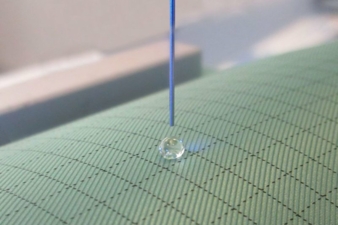13/04/2021 – Protective clothing — auf Deutsch lesen
Krüss: New study shows reusable solution
A new study shows how reusable, water-repellent cleanroom coveralls could be used as medical protective clothing.
The materials studied as part of a research collaboration showed very good liquid-repellent properties, as required to shield infectious droplets. The contact angle method, which was the focus of the study, proved to be valid and can potentially be used as an easily accessible method for testing medical protective clothing. In addition to the Hamburg-based measuring equipment manufacturer Krüss, the study involved Dastex Reinraumzubehör (engl. Cleanroom accessories) GmbH & Co. KG, and OHB System AG, which played a key role in initiating the study.
Whether and how protective clothing and utensils can be reused against droplet infections is currently part of the public debate.
But despite the increased incidence of infection and associated supply bottlenecks, the medical community has been hesitant to respond – for good reason, as conventional disposable clothing offers reliable protection that must first be ensured and proven for reusable textiles.
A new study on the wettability of coated cleanroom garments takes an important step.
First, the fabric was certified to have excellent liquid-repellent behavior on the basis of larger water droplets. To further investigate the protection in contact with coughing or sneezing patients, tiny droplets were applied to the materials at high speed. Microscopy-based contact angle measurements also demonstrated a good protective effect for this situation, which could even be verified on the basis of individual fibers. Reuse was also shown to be feasible. After 120 washing cycles, no impairment of the water-repellent material properties could be detected.
Contact angle measurement as a valid test method for protective clothing
Until now, the protective effect of medical clothing could only be determined in specialized laboratories. In contrast, coated textiles for other uses are often tested using improvised methods that are hardly scientifically adequate.
Contact angle measurements, on the other hand, are not only valid for characterizing hydrophobic textiles, but can also be carried out quickly, easily and on a mobile basis.
In parallel, scientists at Helmholtz Zentrum Geesthacht at DESY, together with quality analysis (Nürtingen) and Volume Graphics (Heidelberg), have visualized the round shapes of non-wetting droplets in high-resolution computed tomographic studies.
There is still a long way to go before medical facilities can switch to reusable protective clothing. But it is certainly worthwhile, not only for ecological reasons and in the event of supply bottlenecks. Doctors and nurses could benefit from more comfortable and breathable protective clothing.




